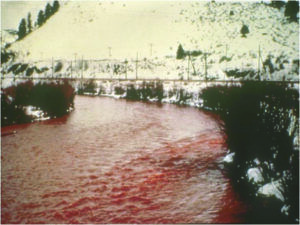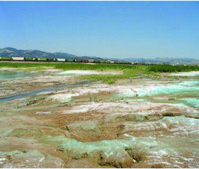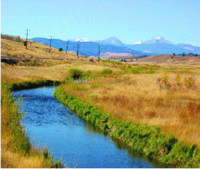The history of the Upper Clark Fork River is truly a tale of three rivers. The river before industrial mining. The river during the heyday of metal extraction. The river being revived.
Up until the time that European settlers moved into the area in significant numbers, a couple of the local place names indicate that the upper Clark Fork was good fishing. According to National Trout Unlimited’s Upper Clark Fork Restoration project manager Casey Hackathorn, the confluence of the Blackfoot River with the Clark Fork was known by the Salish and Kootenai as “the Place of Big Bull Trout.” The spot where Rattlesnake Creek flows into the Clark Fork in Missoula was called “the Place of Small Bull Trout.” Up at Silver Bow Creek, “the Place Where Something is Shot in the Head” was a place with such large bull trout that you could shoot them with a bow and arrow.
“That has not been the case for a lot of time since then,” said Hackathorn as he gave an update on the recovery efforts on the Upper Clark Fork to members of the Bitterroot Chapter of Trout Unlimited last week in Hamilton.

As industrial mining began in the area the river’s story becomes “a tale of woe,” as Hackathorn put it. “But it is a story that everyone should know who cares about fish or conservation in western Montana,” he added.
The tale of woe begins when gold was discovered on Gold Creek near present-day Drummond in 1858 and not long after on Silver Bow Creek and at Butte. Activity in the area boomed and by 1880 the Northern Pacific Railroad was completed near Phosphate and a Golden Spike was set in the tracks near Gold Creek by Ulysses Grant. The actual spike is housed in the State Capitol Rotunda in Helena today. At the time the mine at Phosphate was the richest mine on earth.
By the turn of the 19th century, 12 smelters were located on Butte hill and Silver Bow Creek had become an industrial wasteway. Ten thousand miles of underground tunnels were built under Butte before the open pit mine was begun. When Butte became too polluted the smelting was moved to Anaconda. That smelter stack was the largest free-standing structure in the world for while.
In 1905, William Clark built the Milltown Dam to power the lumber mill at the bottom of the Blackfoot River. Not long after the dam was installed, however, the perfect storm hit in 1908 and a massive 500-year flood event washed all the waste ore that had been piled in large mounds at the smelter into Silver Bow Creek and flushed it down to the Milltown Dam which was topped by floodwaters estimated at 50,000 cfs going over the top of the dam.
The 1908 event washed approximately 100 billion kilograms of heavy metal-laden mine tailings sourced from Butte and deposited it along the floodplain of Silver Bow Creek and the Clark Fork River – an area stretching from Butte to Milltown Dam near Missoula. These wastes were laced with toxic levels of arsenic, cadmium, copper, lead and zinc, and distribution by the flood left widespread contamination in the floodplains of Silver Bow Creek and the Upper Clark Fork River.

As a result of the heavy metals contamination in the basin, water quality and associated aquatic ecosystems were severely impacted. From the late 19th Century to the early 1970s, the Clark Fork River occasionally “ran red” with acid and smelting wastes discharged from the Butte mines and the smelter in Anaconda.
Eventually ranchers along the Clark Fork near Deer Lodge sued the Anaconda Copper Company, which owned the mines, over the pollution and part of the settlement included creating the large settling ponds around Warm Springs to precipitate metals. The ponds are treated with lime to change the pH of the water, suppressing the breakdown of the toxic metals.
“The ponds are stocked with rainbows, but it is a treatment plant,” said Hackathorn.
They are settling ponds.” It is estimated that there is 19 million yards of contaminated material under the ponds that there is no plan to remove.
The open pit mining continued at Butte until the 1980’s when Atlantic Richfield Company (ARCO) bought the mine. But the bottom dropped out of the copper market and the mine was not operated.
This, according to Hackathorn, was a major stroke of luck for the restoration efforts going on because the petroleum company that bought the mine is still solvent. If the Anaconda Copper Company had declared bankruptcy instead of selling out there would be no responsible party to pay for the clean-up. As it is, Atlantic Richfield was left holding that responsibility and they are paying for a lot of the clean-up.
The pollution piling up behind the Milltown Dam was becoming an ever-increasing health problem as all the tailings behind the dam were being pushed down into the aquifer and arsenic was showing up in the drinking water wells in Milltown and Bonner. Then came some ice scours that threatened the dam in the late 1990’s and the reservoir behind the dam was drained. There was a fish kill downstream. And in the intervening years pike had been introduced from Seeley Swan and out-competed the bull trout in the shallow warm reservoir. More bull trout were being found in pike bellies than there were moving down over the dam.
In 2003, Governor Judy Martz took action and three years later clean-up had begun.
Three million yards of contaminated soils were hauled out for deposition elsewhere by train. Another several hundred thousand yards is being stored on a nearby bluff. By 2011 the entire project was complete.
While the basin was being evaluated for Superfund designation, in 1983 the state of Montana pursued legal action to address the widespread injuries to the state’s natural resources in the Upper Clark Fork basin and sued ARCO over it.
After 25 years of litigation, the lawsuit was resolved through a series of three settlement agreements, the last of which was finalized in 2008 and resulted in ARCO paying the State more than $168 million for clean-up. Settlement funds have typically been divided between restoration and remediation. Remediation is primarily the process of cleaning up mining waste while restoration involves returning natural resources back to a healthy condition. Since the U.S. Environmental Protection Agency and the State of Montana began suing ARCO in 1983, the company has paid out approximately $500 million for restoration and remediation projects in the Upper Clark Fork River Basin. $230 million from a 1999 settlement was paid for restoration in the whole basin from Butte to Milltown. In 2005 another settlement amount was dedicated to remediation and restoration related to the Milltown Dam removal. The latest settlement in 2008 brought in $168 million for river floodplain remediation and restoration from below the Warm Springs holding ponds to Garrison Junction.
So, how is all the restoration and remediation work going?
Not as well as expected, it turns out. Based on the restoration plan the project was estimated to be accomplished in 2011 but work is still underway. Because of the huge amount of contamination that was discovered in the restoration process, it is now estimated that a full clean-up could take another 15 to 20 years.
“There was just a lot more contamination out there than anyone expected,” said Hackathorn “and to add to the problem the project is underfunded.” He said in the meantime the Berkley Pit (at Butte) began filling with toxic metal-laden water that is currently being pumped out and treated, but the pumping and treating is expected to go on indefinitely and at the same time mining of copper continues right alongside the current pit but covering a larger area.
According to Hackathorn, the big remodel job being done on the Clark Fork River is a lot like a house remodel. There are a lot of trade-offs made due to the limits on the funding.
“The assumptions that were made going into the project were way too rosy,” said Hackathorn. “We found way more contamination than we expected and the sheer volume of it all is the rub when it comes to cost.”
Although restoration actions are anticipated to enhance aquatic resources in the Basin, the Montana Natural Resources Damage Program has acknowledged that there are practical limits to how well the river basin can be restored. Over 100 years of intensive mining and mineral processing have damaged the natural resources of the Basin so extensively that “no amount of money can restore fully all the injured resources of the Upper Clark Fork River Basin.”
And what about the fish?
Here again things haven’t gone exactly as expected. But a lot of headway has been made. Due to this contamination, the mainstem of the Upper Clark Fork River (above the confluence with Rock Creek) was devoid of fish life from the 1890s to the late 1950s. While the lower part of the mainstem from Rock Creek to Missoula seems to be recovering in fish population and is expected to reach levels comparable with other rivers in Montana, the upper section of the river from below the Warm Springs ponds to Rock Creek are showing very depressed populations in various places. Just below the ponds the fish per mile increased to dozens and in places up to 200 per mile. But nothing close to the 2,000 per mile before the work started. From Flint Creek to Rock Creek the numbers are about 50 per mile.
But below Rock Creek, numbers improve. The farther you go down river from the ponds and the Deer Lodge valley, according to Hackathorn, the numbers are getting better.
Hackathorn said that the experts are stumped over the reasons for the low numbers, but they are pretty sure that it is not due simply to the work that was done. It may be just due to the changed habitat plus the ongoing mining work or other reasons. Since it is mainly populated with brown trout, he said, they may be suffering from the same sorts of decline that brown trout populations are experiencing all over southern Montana. Right now, it remains a mystery.

Progress is being made in the tributaries that can expedite the repopulation of the mainstem, such as the work done on Silver Bow Creek. At the initiation of the remediation work in the late 1990s, the creek had been devoid of fish for many decades. As remediation and restoration progressed, the fishery responded. Complementary work done on fish passage and flow in a key tributary, German Gulch, allowed native fish to recolonize Silver Bow Creek. By 2006, fish were reported in Silver Bow Creek for the first time in more than 100 years. A fishery assessment from 2015 found both native westslope cutthroat and brook trout along most of the length of Silver Bow Creek below Butte. Other promising results are showing up elsewhere such as in Flint Creek and the Little Blackfoot. 
“The Upper Clark Fork watershed encompasses about 4,500 square miles with 120 miles of mainstem river and managing its rehabilitation is a unique challenge,” said Hackathorn. “It’s in the center of the largest geographic complex of Superfund Sites in the country.”
“This is all being done in support of the idea of trying to bring the river back to life and it’s a multi-decade process,” said Hackathorn. “At this point I just hope to see it done before I’m dead.”